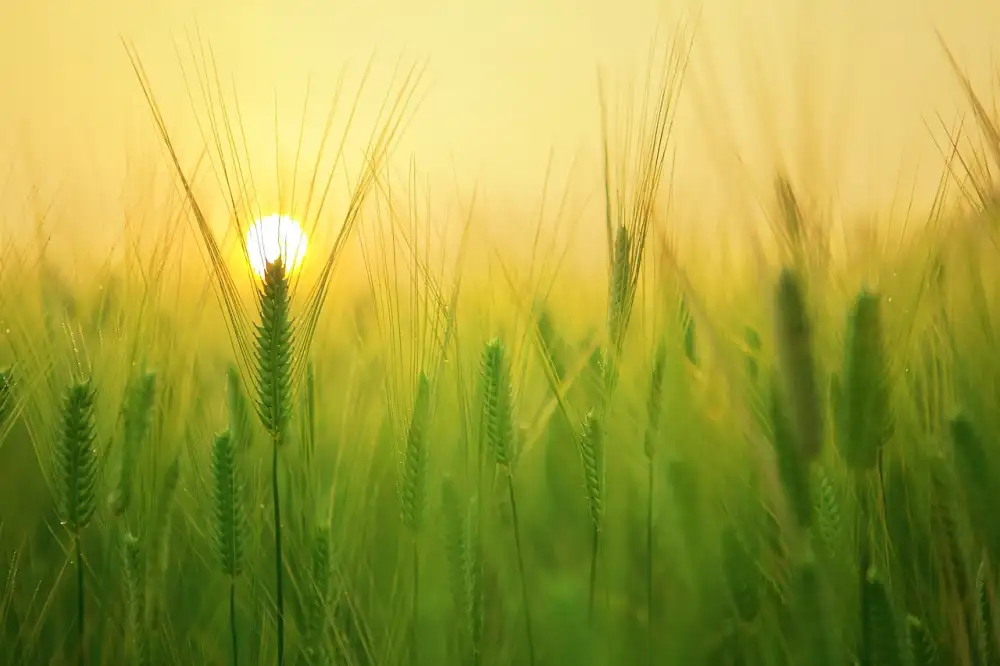Unlocking the Secrets: When is the Best Time to Harvest Rhubarb at Home?

Rhubarb, with its vibrant red stalks and tangy flavor, is a versatile vegetable that can be used in a variety of delicious dishes. Whether you're a seasoned gardener or just starting out, harvesting rhubarb at home can be a rewarding experience. But when is the best time to harvest this delectable plant? Understanding the growth cycle of rhubarb and knowing the signs that indicate it's ready for harvest are key to unlocking the secrets of successful rhubarb harvesting. In this article, we will explore the optimal time to harvest rhubarb, how to properly harvest it, and tips for maximizing your yield. So grab your gardening gloves and get ready to dive into the world of rhubarb harvesting!
Understanding the Growth Cycle of Rhubarb
Rhubarb, a perennial vegetable known for its tart flavor and vibrant red stalks, follows a distinct growth cycle. To successfully harvest rhubarb at home, it is crucial to understand this cycle.
In early spring, rhubarb emerges from its dormant state as small buds break through the soil. These buds quickly develop into large, lush leaves that provide energy for the plant. During this stage, it is important not to harvest any stalks as the plant needs time to establish itself.
As the season progresses, rhubarb enters its growth phase. The leaves continue to expand, capturing sunlight and converting it into energy through photosynthesis. This energy is stored in the roots and used for future growth.
During this phase, you may notice some flower stalks forming. It is advisable to remove these flower stalks promptly as they divert energy away from the development of edible stalks.
After approximately 8-10 weeks of growth, rhubarb reaches maturity. The stalks become thick and firm while maintaining their vibrant color. This is when they are ready for harvest.
It is important to note that rhubarb should not be harvested during its first year of planting. Allowing the plant to establish strong roots and grow undisturbed will ensure a bountiful harvest in subsequent years.
By understanding the growth cycle of rhubarb, you can determine when your plants are ready for harvest and enjoy an abundant supply of this delicious vegetable throughout the season.
Signs that Rhubarb is Ready for Harvest
Knowing when to harvest rhubarb is crucial to ensure the best flavor and texture. Here are some signs that indicate your rhubarb is ready for harvest:
1. Size of Stalks: Mature rhubarb stalks should be thick and sturdy, typically around 1 inch in diameter. Avoid harvesting thin or spindly stalks as they may not have reached their full potential.
2. Color: Look for vibrant, deep red or pink stalks. The color indicates that the rhubarb has developed its characteristic tartness and sweetness.
3. Firmness: Gently squeeze the stalks to check for firmness. Ripe rhubarb should feel crisp and taut, indicating optimal juiciness.
4. Leaf Size: Pay attention to the size of the leaves attached to the stalks. Large, healthy leaves are a good indication that the plant has had enough time to develop fully.
Remember, it's essential not to harvest rhubarb during its first year of growth as it needs time to establish strong roots. By observing these signs, you can ensure a bountiful and flavorful harvest from your rhubarb plants.
Best Time of Year to Harvest Rhubarb
The best time of year to harvest rhubarb is in the spring, typically from April to June. This is when the plant is at its peak growth and the stalks are firm and vibrant in color. It's important to wait until the rhubarb plant is at least three years old before harvesting, as this allows it to establish a strong root system. Harvesting too early can weaken the plant and reduce future yields. By waiting until the third year, you'll ensure a bountiful harvest for years to come.
How to Harvest Rhubarb Properly
To harvest rhubarb properly, it is important to follow a few key steps. First, wait until the plant is at least three years old before harvesting any stalks. This allows the plant to establish a strong root system and ensures a healthy future crop.
When harvesting, grasp the stalk firmly near the base and gently pull it away from the plant. Avoid twisting or yanking, as this can damage the plant. Only harvest about one-third of the stalks at a time to allow the remaining ones to continue growing.
It's crucial to cut off any leaves attached to the harvested stalks immediately. Rhubarb leaves contain high levels of oxalic acid, which can be toxic if ingested in large quantities. Discard the leaves in a compost pile or dispose of them safely.
Remember not to harvest rhubarb too late in the season, as this can weaken the plant and reduce next year's yield. Stop harvesting when the stalks become thin and start to lose their vibrant color.
By following these guidelines, you can ensure a successful rhubarb harvest while maintaining the health and productivity of your plants.
Storing and Preserving Rhubarb
Once you have harvested your rhubarb, it's important to know how to store and preserve it properly to ensure its freshness and flavor. Here are some tips to help you make the most of your rhubarb harvest:
1. Trim the stalks: Remove any leaves from the stalks as they are toxic. Cut off the ends of the stalks and discard any damaged or discolored parts.
2. Wash and dry: Rinse the stalks under cold water to remove any dirt or debris. Pat them dry with a clean towel or paper towel.
3. Refrigerate: Place the rhubarb stalks in a plastic bag or wrap them in a damp paper towel, then store them in the refrigerator. Rhubarb can stay fresh for up to two weeks when stored this way.
4. Freezing: If you have an abundance of rhubarb, freezing is a great option for long-term storage. To freeze rhubarb, cut it into small pieces and blanch them in boiling water for a minute or two. Then, transfer the blanched pieces into an ice bath to stop the cooking process. Drain well and pack them into freezer-safe bags or containers before placing them in the freezer.
5. Canning: Another way to preserve rhubarb is through canning. You can make rhubarb compote or jam by cooking it with sugar and lemon juice, then sealing it in sterilized jars using proper canning techniques.
Remember that frozen or canned rhubarb may lose some of its texture but will still retain its delicious flavor for use in pies, crumbles, sauces, and other recipes throughout the year.
By following these storing and preserving methods, you can enjoy your homegrown rhubarb even after its harvest season has ended.
Tips for Maximizing Rhubarb Yield
1. Fertilize regularly: Rhubarb plants thrive on nutrients, so it's important to fertilize them regularly. Use a balanced fertilizer high in nitrogen in early spring and again after the first harvest to promote healthy growth.
2. Mulch around the plants: Applying a layer of organic mulch around the base of rhubarb plants helps retain moisture, suppress weeds, and regulate soil temperature. This promotes optimal growth and increases yield.
3. Adequate watering: Rhubarb plants require consistent moisture throughout the growing season. Water deeply once or twice a week, ensuring the soil is evenly moist but not waterlogged. Avoid overhead watering as it can lead to disease.
4. Regular harvesting: Harvesting rhubarb stalks regularly encourages new growth and increases overall yield. Start harvesting when the stalks are thick and reach about 10-15 inches in length. Always leave a few stalks intact to allow the plant to continue photosynthesis.
5. Divide and replant: Every 4-5 years, divide mature rhubarb crowns to rejuvenate the plant and maximize yield. Dig up the crown in early spring or late fall, separate it into smaller sections with at least one bud each, and replant them in well-prepared soil.
6. Weed control: Keep your rhubarb patch weed-free by regularly removing any competing vegetation around the plants. Weeds can hinder growth and rob nutrients from your rhubarb crop.
By following these tips, you can ensure that your rhubarb plants are healthy, productive, and provide you with an abundant harvest year after year!
Now that you have successfully harvested your rhubarb, it's time to enjoy the delicious fruits of your labor. Rhubarb is a versatile ingredient that can be used in a variety of dishes, from pies and tarts to jams and sauces.
One popular way to savor the tangy flavor of rhubarb is by making a classic rhubarb pie. The tartness of the rhubarb pairs perfectly with a sweet, buttery crust, creating a delightful balance of flavors.
If you're looking for something simpler, try stewing rhubarb with sugar and serving it over vanilla ice cream or yogurt. This quick and easy dessert is a refreshing treat on a hot summer day.
Another option is to make homemade rhubarb jam. Spread it on toast or use it as a filling for pastries – either way, you'll be able to enjoy the vibrant taste of rhubarb all year round.
Remember, when cooking with rhubarb, remove any leaves as they are toxic. Only use the stalks for culinary purposes.
So go ahead and explore the many possibilities that rhubarb has to offer. With its unique flavor and versatility, this humble plant can truly elevate your culinary creations. Happy harvesting and bon appétit!
Published: 24. 02. 2024
Category: Home



